Greetings everyone! My name is Valkyrie and today marks the beginning of a new MTG Arena series focused on the beloved Standard format - Deconstructing Standard! In this series we will be going through many of the Standard format's top decks in the metagame, and breaking them down to try and figure out what makes them so powerful. This week we're going to start with what was for quite a while one of the best decks in the metagame, Mono Red Aggro!
But before we begin, let me make one thing clear: Feedback is 100% appreciated. In fact, it's encouraged. Is there something in this article that you agreed with? Anything you disagreed with? Are there any decks you would like me to cover in future episodes of Deconstucting Standard? Let me know in the comments below - I want to hear about it!
So, without further ado, let's talk about Mono Red.

Introduction
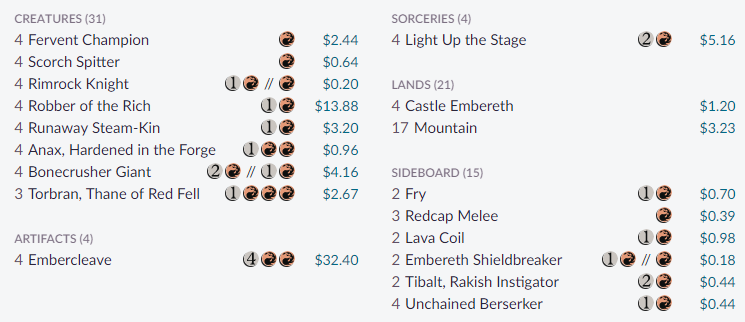
Click here to see the decklist on Scryfall!
Mono Red Aggro is an aggressive deck that seeks to flood the board with creatures, using burn spells, card advantage and Embercleave to overwhelm the opponent. It is, at its core, a deck that seeks to play to the battlefield, attaching Embercleave to a large creature and smashing face for a ton of damage in a single turn. It is incredibly strong against slower decks that take a few turns to establish proper threats, as the Mono Red player is usually miles ahead before the opponent has a chance to do anything meaningful.
This deck is all about creatures - the majority of our spells are creatures, and thus it is vitally important that we establish a powerful board state early on. If we lose the board with this deck, we lose the game - it's that simple. Luckily, we have access to powerful card advantage spells in Robber of the Rich and Light Up the Stage, that allow us to be sure that we can continue to establish threats on the battlefield and never run out of cards.
With that in mind, let's talk about the tools we have to help us pressure our opponent.
Pressure
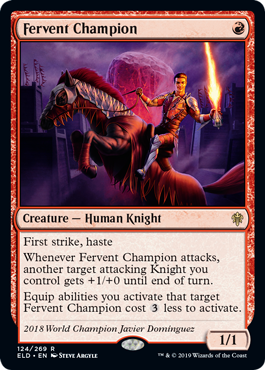
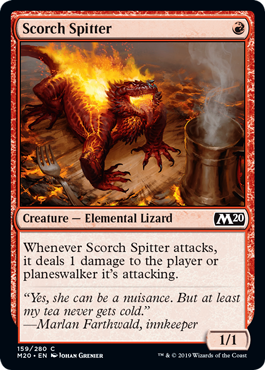
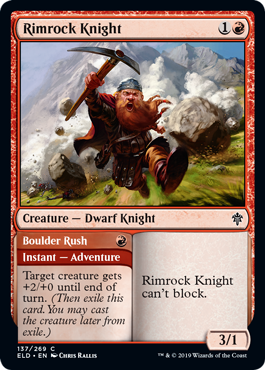
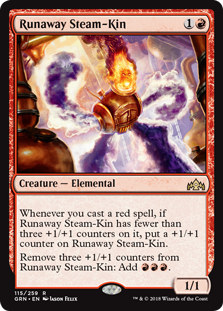
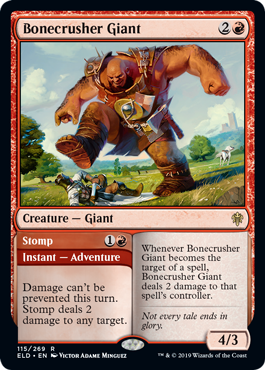
One of the first things this deck wants to do is to establish a clock on your opponent's life total. Thus, it is vitally important that this deck applies pressure on the opponent from the very first turn. Luckily, the mono red deck has more than enough ways to do this, as well as multiple ways to keep your hand filled so you can speed up your clock.
Let's start with our one-drop creatures. Fervent Champion is a powerful aggressive one-drop creature as having first strike in addition to haste makes it less likely to trade with your opponent's 1-drop on turn two, which would otherwise stifel the possibility of a turn-two Light Up the Stage. Pumping up your Rimrock Knights or even your other Fervent Champions is also useful in a deck that wants to be aggressive, and being able to equip to Embercleave for FREE can steal games out of nowhere. Scorch Spitter is another powerful 1-drop that is a great creature to have when you need to use Light Up the Stage to find your next few land drops, as it deals damage to your opponent when attacking, regardless of whether or not your opponent blocks it.
Rimrock Knight doesn't appear to be too great on the surface, as one-cost combat tricks are never usually what an aggressive red deck looks for, but the fact that this is a one-cost combat trick stapled to a 3/1 body is what makes this card so powerful. This card works incredibly well with Embercleave (a card we will be discussing later) as casting an Embercleave on a small creature only to pump it up later and have it deal even more damage is exceptionally powerful. Not only that, but you're left with a 3/1 body that both puts a clock on your opponent if left unchecked, while also fuelling a second Embercleave.
Runaway Steam-Kin has been a staple of red-based aggressive decks ever since it was introduced to Standard with Guilds of Ravnica. A powerful creature that gets bigger as you put more threats onto the battlefield is already an incredibly valuable card for a red aggressive deck, and being able to shrink it for three red mana only for it to grow again is bordering on BUSTED. However, there is a caveat to this as it's an incredible removal magnet. Therefore, it is important that your turns don't rely too heavily on this card, as it's at it's best as a facilitator rather than an enabler for your strategies.
Cards that remove a relevant threat off the battlefield while also being a threat themselves tend to be pretty powerful in Standard, and Bonecrusher Giant is no exception to this rule. Being able to use Stomp to be rid of threats such as Robber of the Rich and Legion Warboss that are small but incredibly threatening is always nice to have, and being able to flout damage prevention from protection spells is niche but useful in many games.On top of that, a 4/3 body for three mana that punishes your opponent for interacting with it makes this card an absolute all-star in this deck.
Card Advantage
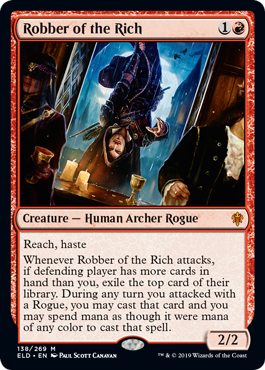
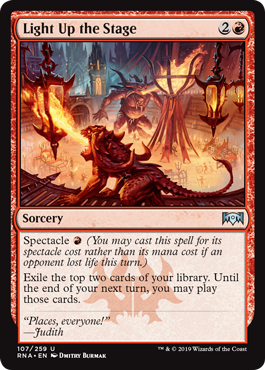
So, we've established some threats on the battlefield, and our opponent is struggling to keep up. But there's just one problem - you're Out of Cards™! What do we have in our arsenal to stop this from happening?
First off, we have Robber of the Rich. I've been a huge fan of this card ever since it was released - a two-cost 2/2 with haste is already a great card to run in our deck, but Robber being able to draw cards from your opponent's deck allows it to generate insane card advantage while simultaneously stripping your opponents of their resources. This card does everything - it pressures the opponent, generates card advantage, renders your opponent's Temples near-useless, and punishes opponents who keep slow hands. What makes it even better is that you don't even need to worry about filling Robber's requirement - if your deck is doing what it's supposed to do, Robber's effect will trigger almost every turn. And to make things even better, it gets around Narset, Parter of Veils's static ability.
This card is especially good against slower decks such as Jeskai Fires and Temur Reclamation as they revolve around a small set of key cards, and use Temples to help dig through their deck for their key cards. Thus, being able to exile the top card of their library every turn with Robber is incredibly disruptive for our opponents, especially if they spent their turn using a Temple of Epiphany to keep a Fires of Invention on the top of their deck. Being able to cast our opponent's Teferi, Time Raveler and use it against them is also a nice bonus.
On its own, Light Up the Stage is a worse Divination in red - decent in Limited formats but nowhere near good enough for Constructed play. What makes it so powerful, however, is its Spectacle cost - so long as you have dealt even a single point of damage to your opponent in a turn, Light Up the Stage costs one mana. You pay one mana to draw two cards, which, yet again, gets around Narset's static ability. In a deck that seeks to kill your opponent quickly and dump out your hand as early as turn 3 or 4, Light Up the Stage is the Holy Grail of card advantage cards.
The Mono Red deck mulligans much better than variants of Mono Red we've seen in previous Standard formats, and it's all because of this card. I've kept many one-landers that contain a couple one-drops, some more expensive cards and a Light Up the Stage, because those one-drops make it incredibly likely for you to be able to cast Light Up on turn two for one mana, which is quite likely to find those second and third land drops that you need to curve out and kill your opponent. If you're unlucky enough to not find any land drops after that, then that was a game you were not going to win in the first place.
Win Conditions
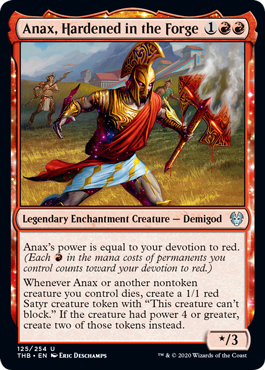
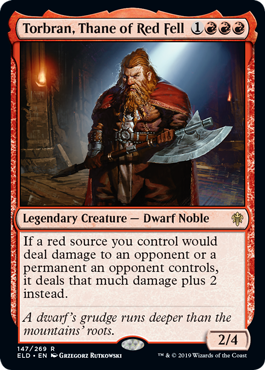
Anax, Hardened in the Forge is a new addition to the Mono Red deck, and it's a POWERFUL one. At worst, Anax is a 2/3 for three that gets bigger as you play threats and leave a 1/1 Satyr behind when it dies. At its best, it's a huge creature that continues to have an impact on the board even after it dies, as the 1/1 Satyrs it generates synergize incredibly well with Torbran, Thane of Red Fell's ability. Playing Torbran into a board of 1/1 Satyrs can end games out of nowhere, so playing a card such as Kaya's Wrath or Shatter the Sky with an Anax on the battlefield is always a risky play.
The biggest reason to play Anax however is because of Embercleave. Because Embercleave contributes to devotion when you play it, it makes Anax bigger. Attach Cleave to an attacking Anax, and the game is most likely over because, at worst, you've got a 5/4 Anax with double strike and trample. That's 10 damage to the face if left unblocked. And with all the other creatures on the battlefield contributing to devotion, Anax is likely going to be bigger than that, and attacking for a LOT more damage.
What's interesting about this card is that it's often the best play to play a second Anax with one already on the battlefield. Why is this, I hear you ask? Since both Anaxes contribute to devotion when you sacrifice one to the legend rule, both of our Anaxes are at at least 4 power. Thus, when you sacrifice your new Anax to the legend rule, since he was at 4 power, both triggers from both Anaxes grant you two Satyrs, netting you four satyrs in total. With an Embercleave or a Torbran in hand, you're now in a position to win in a couple turns, if not the following turn.
Torbran, Thane of Red Fell takes the four-drop slot in this deck, and make no mistake as it's a good one. It's definitely no Hazoret the Fervent, but that doesn't mean it doesn't end games. As it turns out, turning those one-drops you cast in the early turns (that are otherwise not doing much to pressure your opponent) into big, threatening beaters is a good way to swing the game in your favour. This deck only runs three copies of Torbran, simply because while drawing and playing multiple copies of Anax is really powerful, drawing a second Torbran when you already have one on the battlefield feels pretty bad. Nonetheless, this card is definitely incredibly powerful, and does a lot to pressure the opponent and end the game.
Let's dig a bit deeper now - what powerful interactions are there between Torbran and other cards in our deck?
- Both Shock and Stomp now deal 4 damage to any target for one and two mana respectively. Compare this to Slaying Fire, which costs three mana and only deals four damage if you spend only red mana to cast it.
- Scorch Spitter now deals three damage to your opponent or one of their planeswalkers when it attacks.
- Anax's Satyrs now deal 3 damage a piece with Torbran on the battlefield.
- Torbran works pretty well with Embercleave - dealing two extra damage to both creatures that block it and whatever the creature is attacking.
Regardless of how you use it, Torbran is a powerful creature that threatens to end games if left unchecked.
Embercleave
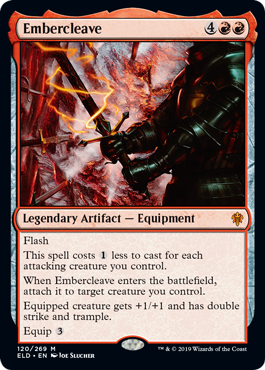
The big one.
Oh boy, here we go.
Let's talk about Embercleave. This card is the finisher to end all finishers - arguably one of the best finisher cards we've seen printed in recent Standard sets.
The Mono Red deck, at its core, is all built around this card. Here's a rundown of how a typical game goes:
Step 1: Play a multitude of small creatures, using card advantage spells and powerful creatures to pressure the opponent.
Step 2: Attack with at least 4 creatures. Embercleave now costs two red mana.
Step 3: Before damage is dealt, attach Embercleave to the largest attacking creature on the battlefield.
Step 4: Profit.
That's it. If you have creatures on the battlefield and an Embercleave, you've most likely won the game.
I could write an entire essay on why Embercleave is a busted Magic card, because there are so many things to say about it. However, there's not enough room to
Embercleave has flash - it has to, because without flash its cost-reducing ability would mean absolutely nothing. But what this means is that you can cast it before damage and kill your opponent when they least expect it. This makes it weak to decks that run Teferi, Time Raveler, as it foces you to play Cleave in your main-phase for six mana, which isn't the best investment. This isn't a huge issue though as paying 6 mana to potentially end the game is still decent, and our deck already has ways of dealing with an opposing Teferi, Time Raveler.
This equipment instantly attaches itself to a creature upon entering the battlefield, so you get its benefits without even having to pay the equip cost. Upon equipping to a creature, it grants +1/+1, double strike and trample to the creature it equipped. While double strike on its own is not incredibly relevant - it essentially means that it trades exceptionally well with creatures - the fact that it also grants trample is INCREDIBLY relevant. Now not only does it trade incredibly well with creatures, but it now also deals excess first strike damage to the face, and deals even more damage to the face once the rest of your creatures get to deal damage. This deadly combination of abilities makes turns even the most unnasuming of creatures into the biggest threat on the battlefield when equipped with Embercleave. This card ends games, does so out of nowhere, and should always be the first card on your mind when playing against ANY Mono Red deck.
Manabase
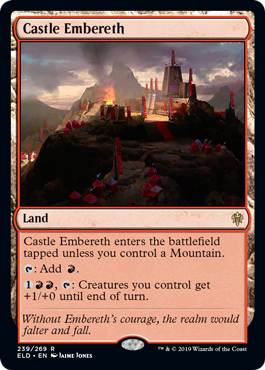
Our manabase for this deck is quite simple - we have 17 Mountains alongside four copies of Castle Embereth in our deck. Now usually with monocolored aggressive red decks, 21 lands seems a bit excessive as our curve is usually quite small - we never want to be flooded with this deck as a turn where we do nothing gives our opponent the chance to stabilise, and our deck is really bad at playing from behind, as we're more about establishing threats and pressuring our opponent than we are about actually removing threats. Nonetheless, in this deck our curve is a bit bigger than usual as we have access to both Torbran and Embercleave, and we want to be able to cast these cards when we need them as they have the potential to end games. In addition, we don't want to have too few Mountains in our deck as we would prefer to avoid Castle Embereth coming in tapped.
Speaking of which, we have four of these castles in our deck. Why? Well, to put it simply - it's provides us with a safety net in case we do get flooded in the late-game. The mana sink ability of Castle Embereth allows us to use our excess lands in order to activate our castle and apply added pressure on our opponent when we're running a bit low on actual spells. In addition, our above average land count allows us to facilitate Castle Embereth that little bit more, allowing it to be relevant more often when we need it.
Sideboard
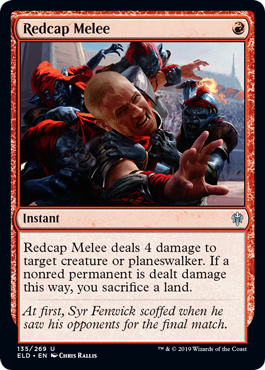
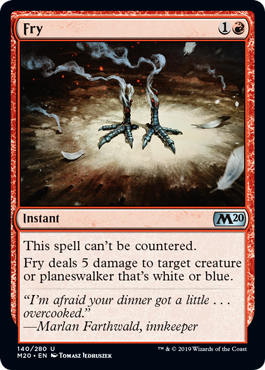
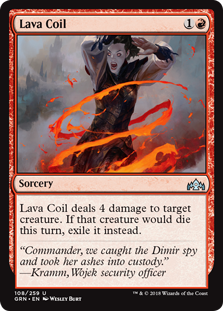
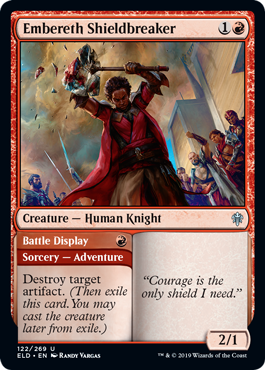
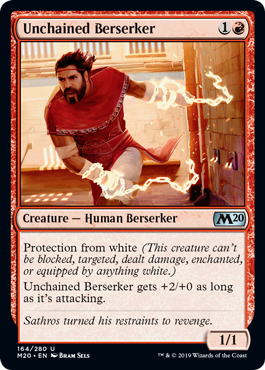
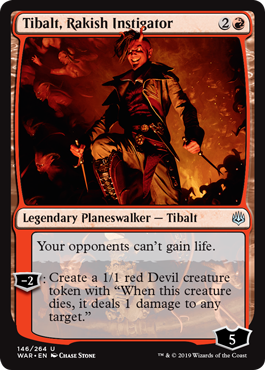
In a metagame filled with Breeding Pool so many different viable decks with varying playstyles, our sideboard needs to be equipped to tackle the rest of the metagame as much as we can. Unfortunately nonetheless, we will have some bad matchups (*cough* Uro *cough*), but that is the nature of Constructed - every deck has its bad matchups. That's not to say these decks are unbeatable however as we do have our ways of sideboarding against our worst matchup - they're just not that great and there are too many cards that line up extremely well with our strategy.
With that out of the way, let's talk about our sideboard. To start off, we have three copies of Redcap Melee for the mirror. This is a powerful removal option for the Mono Red matchup as it cleanly answers every threat the mono red deck can throw at us for just one mana.
Two other removal spells in our deck are Fry and Lava Coil. Fry is a very powerful option for the Blue-based decks such as Jeskai Fires as it cleanly answers some of the deck's most powerful cards - namely Kenrith, the Returned King, Cavalier of Gales, and Teferi, Time Raveler - all while dodging interaction spells. Azorius Control is also a good deck to side this card in against - Teferi is also one of their most powerful threats, alongside Elspeth, Sun's Nemesis, Archon of Sun's Grace, and even Dream Trawler. Lava Coil on the other hand, isn't as powerful as it usef to be as the metagame at the moment is riddles with creatures that have more than 4 health (I'm looking at you, Lovestruck Beast). Nonetheless, it is still a powerful addition to the metagame as there are still creatures like Anax, Hardened in the Forge and Nightpack Ambusher that need to be removed as quickly as possible before they generate too much value. In addition, being able to side Coil in vs Mono Red to deal with an Anax before it can start generating Satyrs, or against Rakdos Aristocrats to exile a Woe Strider so it can't be escaped can be extremely relevant in some games.
At first glance, Embereth Shieldbreaker doesn't bring much to the table. A 2/1 body for two is quite weak, and most red decks don't really have much use for a one-cost artifact killer that does nothing else. Staple them together though, and you have a decent sideboard card for Mono Red. This card is good in keeping the Aristocrats deck in check, as Witch's Oven is one of their key cards. Lucky Clover is also an incredibly important artifact for the Temur Adventures deck, so it's good to be able to have a card that both efficiently deals with it and provides some added pressure. You're also not worried about siding it in against a deck that plays only one artifact, since if they never draw it you still have a 2/1 body for two, which of course isn't ideal but it's enough to be a relevant threat on the battlefield, and so it's good enough that we run two in the sideboard.
Unchained Berserker is an important card in a decent amount of matchups, Primarily Jeskai Fires and Azorius Control as the majority of their answers are white cards, which Unchained Berserker completely ignores. It's also decent against Bant Midrange to a certain extent as they play cards such as Knight of Autumn and Teferi which are relevant to Berserker's protection ability. In general having a threat that is immune to cards like Teferi or Dream Trawler is useful in matchups where those cards is quite relevant relevant, which is why we run four of these in our sideboard - we want to have it as often as possible in these matchups.
And finally, we have two copies of Tibalt, Rakish Instigator. Tibalt is one of the more narrow sideboard cards in our arsenal, as it's in the deck solely to counter decks that run valuable cards that gain life. Being able to stop an Uro or a Dream Trawler from gaining life can help you continue to pressure your opponent's life total without having to worry about cards like Dream Trawler or Uro - cards that often steal games all by themselves due to their powerful lifegain abilities.
End Step
And that's it for today's Deconstructing Standard article! This is a brand new series, so feedback is appreciated! Did you agree with the article? Did you disagree? What decks would you like me to cover in future episodes? I want to hear about it! Let me know in the comments below what you have to say.
Ikoria: Lair of Behemoths previews are just around the corner now, and we are super excited to see what the new set brings to Standard. For the next couple of weeks we will continue to cover the current Standard format, with Ikoria Standard articles to come as soon as the set releases!
Until then, happy spellcasting! Stay safe everyone!
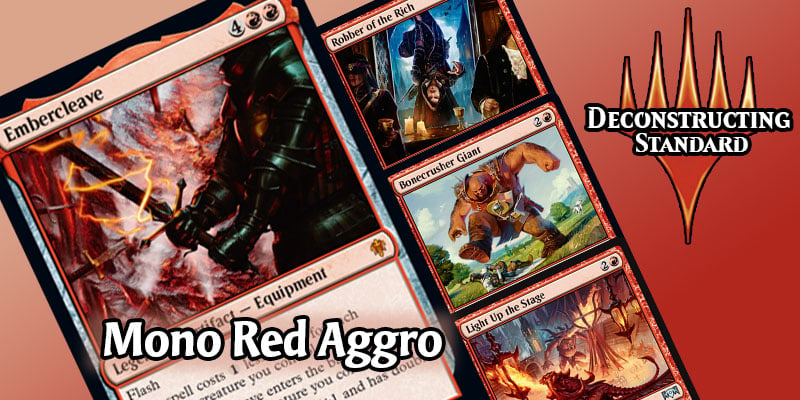
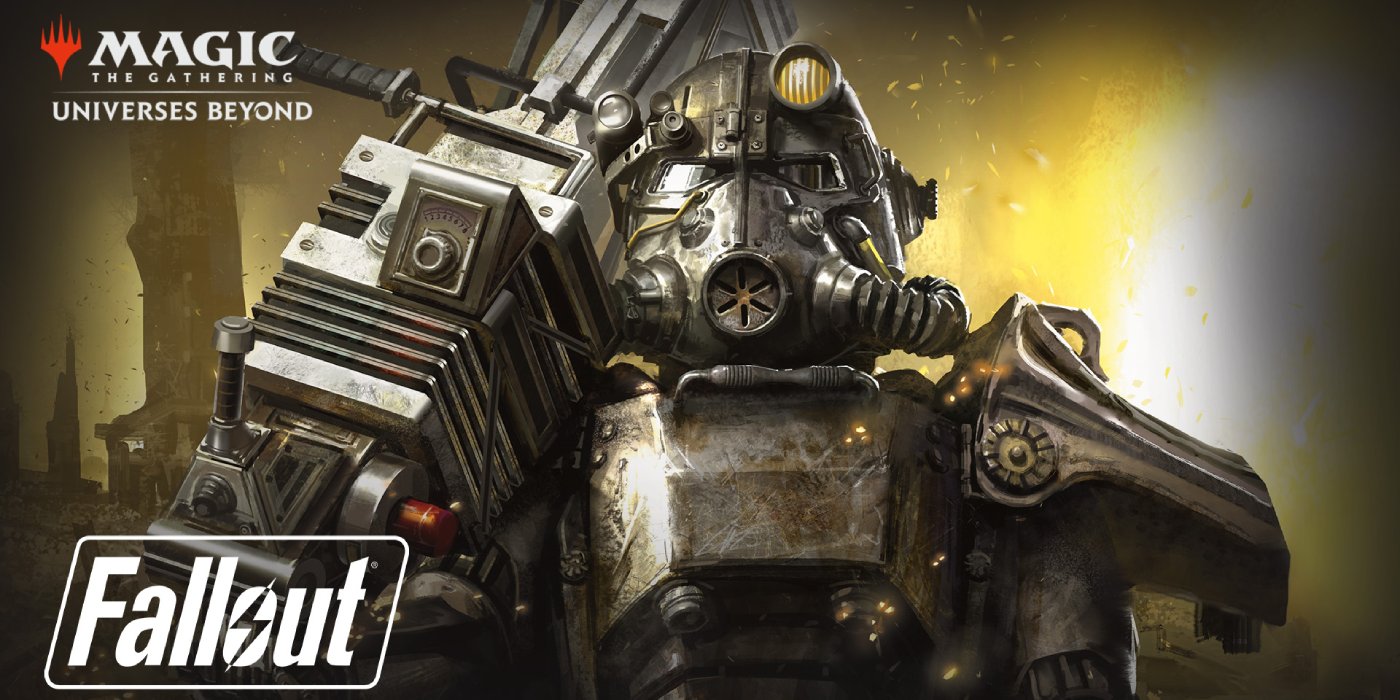
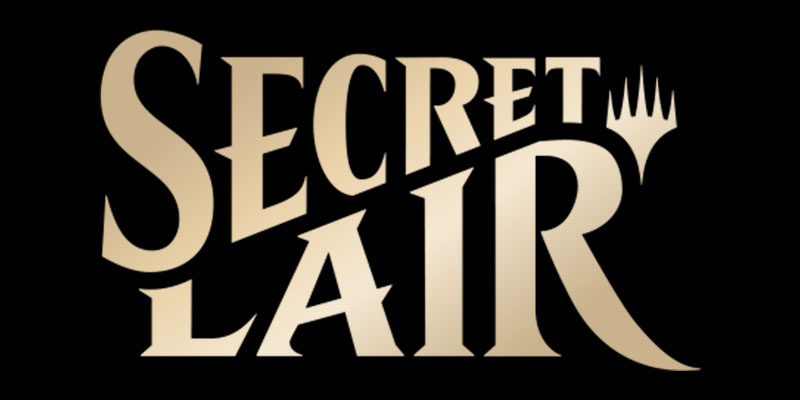

Comments
Great article and idea for a series!
I really think OOC should drop the "daily store deals" posts (they're useless) and focus on real MTGA content such as this! Kudos for you Valkyrie!!
Thanks very much! I'm relatively new to writing articles (I've always considered myself to be more of a creative writer) so it's great to see that there's at least some interest in these Standard articles :)